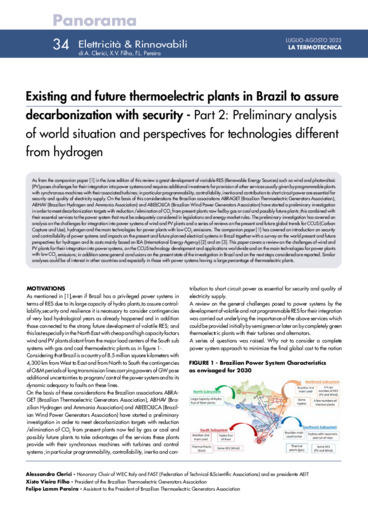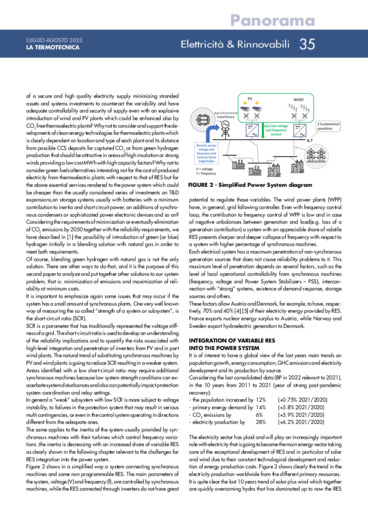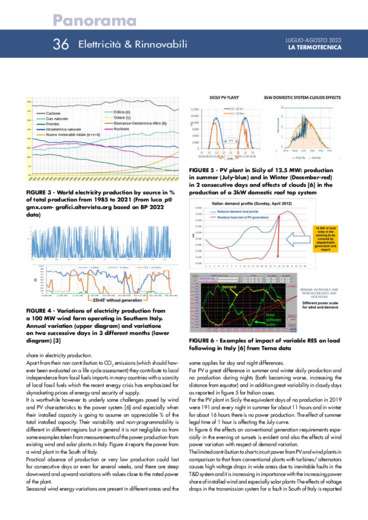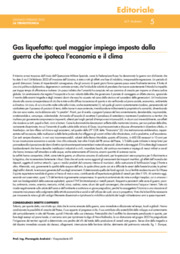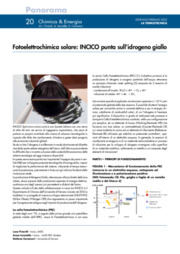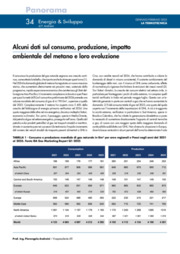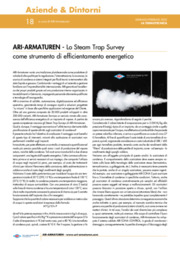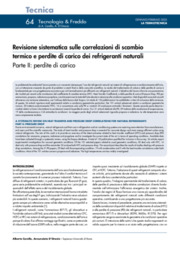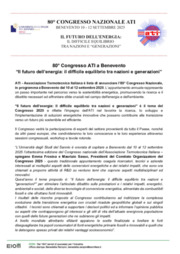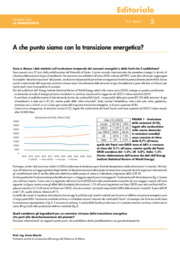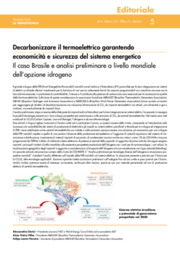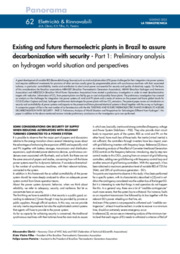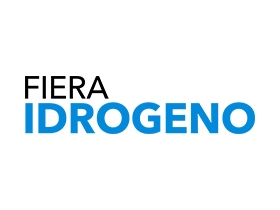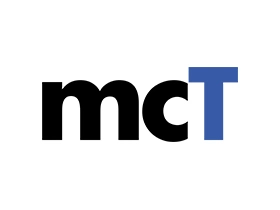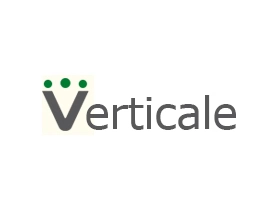Thermoelectric plants to assure decarbonization with security
Existing and future thermoelectric plants in Brazil to assure decarbonization with security
Alessandro Clerici - Presidente onorario FAST e World Energy Council Italia ed ex presidente AEIT; Xisto Vieira Filho, Felipe Lamm Pereira - Presidente e Assistente ABRAGET (Brazilian Thermoelectric Generators Association) - La Termotecnica
Part 2: Preliminary analysis of world situation and perspectives for technologies different from hydrogen
(in lingua inglese)
As from the companion paper [1] in the June edition of this review a great development of variable RES (Renewable Energy Sources) such as wind and photovoltaic (PV) poses challenges for their integration into power systems and requires additional investments for provision of other services usually given by programmable plants with synchronous machines with their associated turbines; in particular programmability, controllability, inertia and contribution to short circuit power are essential for security and quality of electricity supply.
On the basis of this considerations the Brazilian associations ABRAGET (Brazilian Thermoelectric Generators Association), ABHAV (Brazilian Hydrogen and Ammonia Association) and ABEEOLICA (Brazilian Wind Power Generators Association) have started a preliminary investigation in order to meet decarbonization targets with reduction /elimination of CO2 from present plants now fed by gas or coal and possibly future plants; this combined with their essential services to the power system that must be adequately considered in legislations and energy market rules.
The preliminary investigation has covered an analysis on the challenges for integration into power systems of wind and PV plants and a series of reviews on the present and future global trends for CCUS (Carbon Capture and Use), hydrogen and the main technologies for power plants with low CO2 emissions.
The companion paper [1] has covered an introduction on security and controllability of power systems and impacts on the present and future planned electrical systems in Brazil together with a survey on the world present and future perspectives for hydrogen and its costs mainly based on IEA (International Energy Agency) [2] and on [3].
This paper covers a review on the challenges of wind and PV plants for their integration into power systems, on the CCUS technology development and applications worldwide and on the main technologies for power plants with low CO2 emissions; in addition some general conclusions on the present state of the investigation in Brazil and on the next steps considered are reported.
Similar analyses could be of interest in other countries and especially in those with power systems having a large percentage of thermoelectric plants.
Motivations
As mentioned in [1],even if Brazil has a privileged power systems in terms of RES due to its large capacity of hydro plants,to assure controllability, security and resilience it is necessary to consider contingencies of very bad hydrological years as already happened and in addition those connected to the strong future development of volatile RES; and this last especially in the North
East with cheap and high capacity factors wind and PV plants distant from the major load centers of the South sub systems with gas and coal thermoelectric plants as in figure 1-.
Considering that Brazil is a country of 8.5 million square kilometers with 4,300 km from West to East and from North to South the contingencies of O&M periods of long transmission lines carrying powers of GW pose additional uncertainties to program/control the power system and to its dynamic adequacy to faults on these lines.
On the basis of these considerations the Brazilian associations ABRAGET (Brazilian Thermoelectric Generators Association), ABHAV (Brazilian Hydrogen and Ammonia Association) and ABEEOLICA (Brazilian Wind Power Generators Association) have started a preliminary investigation in order to meet decarbonization targets with reduction/elimination of CO2 from present plants now fed by gas or coal and possibly future plants to take advantages of the services these plants provide with their synchronous machines with turbines and control systems; in particular programmability, controllability, inertia and contribution to short circuit power as essential for security and quality of electricity supply.
A review on the general challenges posed to power systems by the development of volatile and not programmable RES for their integration was carried out underlying the importance of the above services which could be provided initially by semi green or later on by completely green thermoelectric plants with their turbines and alternators.
A series of questions was raised. Why not to consider a complete power system approach to minimize the final global cost to the nation of a secure and high quality electricity supply minimizing stranded assets and systems investments to counteract the variability and have adequate controllability and security of supply even with an explosive introduction of wind and PV plants which could be enhanced also by CO2 free thermoelectric plants?
Why not to consider and support the developments of clean energy technologies for thermoelectric plants which is clearly dependent on location and type of each plant and its distance from possible CCS deposits for captured CO2 or from green hydrogen production that should be attractive in areas of high insolation or strong winds providing a low cost MWh with high capacity factors?
Why not to consider green fuels alternatives interesting not for the cost of produced electricity from thermoelectric plants with respect to that of RES but for the above essential services rendered to the power system which could be cheaper than the usually considered series of investments on T&D expansions,on storage systems usually with batteries with a minimum contribution to inertia and short circuit power, on additions of synchronous condensers or sophisticated power electronic devices and so on?
Considering the requirements of minimization or eventually elimination of CO2 emissions by 2050 together with the reliability requirements, we have described in [1] the possibility of introduction of green (or blue) hydrogen initially in a blending solution with natural gas in order to meet both requirements.
Of course, blending green hydrogen with natural gas is not the only solution. There are other ways to do that, and it is the purpose of this second paper to analyze and put together other solutions to our system problem, that is: minimization of emissions and maximization of reliability at minimum costs.
It is important to emphasize again some issues that may occur if the system has a small amount of synchronous plants. One very well known way of measuring the so called "strength of a system or subsystem", is the short-circuit ratio (SCR). SCR is a parameter that has traditionally represented the voltage stiffness of a grid.
The short-circuit ratio is used to develop an understanding of the reliability implications and to quantify the risks associated with high-level integration and penetration of inverters from PV and in part wind plants. The natural trend of substituting synchronous machines by PV and wind plants is going to reduce SCR resulting in a weaker system.
Areas identified with a low short-circuit ratio may require additional synchronous machines because low system strength conditions can exacerbate system disturbances and also can potentially impact protection system coordination and relay settings.
In general a "weak" subsystem with low SCR is more subject to voltage instability, to failures in the protection system that may result in serious multi contingencies, or even in the control system operating in directions different from the adequate ones.
The same applies to the inertia of the system usually provided by synchronous machines with their turbines which control frequency variations; the inertia is decreasing with an increased share of variable RES as clearly shown in the following chapter relevant to the challenges for RES integration into the power system.
Figure 2 shows in a simplified way a system connecting synchronous machines and some non programmable RES. The main parameters of the system, voltage (V) and frequency (f), are controlled by synchronous machines, while the RES connected through inverters do not have great potential to regulate those variables.
The wind power plants (WPP) have, in general, grid following controller. Even with frequency control loop, the contribution to frequency control of WPP is low and in case of negative unbalances between generation and load (e.g. loss of a generation contribution) a system with an appreciable share of volatile RES presents sharper and deeper collapse of frequency with respect to a system with higher percentage of synchronous machines.
Each electrical system has a maximum penetration of non-synchronous generation sources that does not cause reliability problems to it. This maximum level of penetration depends on several factors, such as the level of local operational controllability from synchronous machines (frequency, voltage and Power System Stabilizers - PSS), interconnection with "strong" systems, existence of demand response, storage sources and others.
These factors allow Austria and Denmark, for example, to have, respectively, 70% and 40% [4] [5] of their electricity energy provided by RES. France exports nuclear energy surplus to Austria, while Norway and Sweden export hydroelectric generation to Denmark.
Attached, you can download the full pdf of the article.
The preliminary investigation has covered an analysis on the challenges for integration into power systems of wind and PV plants and a series of reviews on the present and future global trends for CCUS (Carbon Capture and Use), hydrogen and the main technologies for power plants with low CO2 emissions.
The companion paper [1] has covered an introduction on security and controllability of power systems and impacts on the present and future planned electrical systems in Brazil together with a survey on the world present and future perspectives for hydrogen and its costs mainly based on IEA (International Energy Agency) [2] and on [3].
This paper covers a review on the challenges of wind and PV plants for their integration into power systems, on the CCUS technology development and applications worldwide and on the main technologies for power plants with low CO2 emissions; in addition some general conclusions on the present state of the investigation in Brazil and on the next steps considered are reported.
Similar analyses could be of interest in other countries and especially in those with power systems having a large percentage of thermoelectric plants.
Motivations
As mentioned in [1],even if Brazil has a privileged power systems in terms of RES due to its large capacity of hydro plants,to assure controllability, security and resilience it is necessary to consider contingencies of very bad hydrological years as already happened and in addition those connected to the strong future development of volatile RES; and this last especially in the North
East with cheap and high capacity factors wind and PV plants distant from the major load centers of the South sub systems with gas and coal thermoelectric plants as in figure 1-.
Considering that Brazil is a country of 8.5 million square kilometers with 4,300 km from West to East and from North to South the contingencies of O&M periods of long transmission lines carrying powers of GW pose additional uncertainties to program/control the power system and to its dynamic adequacy to faults on these lines.
On the basis of these considerations the Brazilian associations ABRAGET (Brazilian Thermoelectric Generators Association), ABHAV (Brazilian Hydrogen and Ammonia Association) and ABEEOLICA (Brazilian Wind Power Generators Association) have started a preliminary investigation in order to meet decarbonization targets with reduction/elimination of CO2 from present plants now fed by gas or coal and possibly future plants to take advantages of the services these plants provide with their synchronous machines with turbines and control systems; in particular programmability, controllability, inertia and contribution to short circuit power as essential for security and quality of electricity supply.
A review on the general challenges posed to power systems by the development of volatile and not programmable RES for their integration was carried out underlying the importance of the above services which could be provided initially by semi green or later on by completely green thermoelectric plants with their turbines and alternators.
A series of questions was raised. Why not to consider a complete power system approach to minimize the final global cost to the nation of a secure and high quality electricity supply minimizing stranded assets and systems investments to counteract the variability and have adequate controllability and security of supply even with an explosive introduction of wind and PV plants which could be enhanced also by CO2 free thermoelectric plants?
Why not to consider and support the developments of clean energy technologies for thermoelectric plants which is clearly dependent on location and type of each plant and its distance from possible CCS deposits for captured CO2 or from green hydrogen production that should be attractive in areas of high insolation or strong winds providing a low cost MWh with high capacity factors?
Why not to consider green fuels alternatives interesting not for the cost of produced electricity from thermoelectric plants with respect to that of RES but for the above essential services rendered to the power system which could be cheaper than the usually considered series of investments on T&D expansions,on storage systems usually with batteries with a minimum contribution to inertia and short circuit power, on additions of synchronous condensers or sophisticated power electronic devices and so on?
Considering the requirements of minimization or eventually elimination of CO2 emissions by 2050 together with the reliability requirements, we have described in [1] the possibility of introduction of green (or blue) hydrogen initially in a blending solution with natural gas in order to meet both requirements.
Of course, blending green hydrogen with natural gas is not the only solution. There are other ways to do that, and it is the purpose of this second paper to analyze and put together other solutions to our system problem, that is: minimization of emissions and maximization of reliability at minimum costs.
It is important to emphasize again some issues that may occur if the system has a small amount of synchronous plants. One very well known way of measuring the so called "strength of a system or subsystem", is the short-circuit ratio (SCR). SCR is a parameter that has traditionally represented the voltage stiffness of a grid.
The short-circuit ratio is used to develop an understanding of the reliability implications and to quantify the risks associated with high-level integration and penetration of inverters from PV and in part wind plants. The natural trend of substituting synchronous machines by PV and wind plants is going to reduce SCR resulting in a weaker system.
Areas identified with a low short-circuit ratio may require additional synchronous machines because low system strength conditions can exacerbate system disturbances and also can potentially impact protection system coordination and relay settings.
In general a "weak" subsystem with low SCR is more subject to voltage instability, to failures in the protection system that may result in serious multi contingencies, or even in the control system operating in directions different from the adequate ones.
The same applies to the inertia of the system usually provided by synchronous machines with their turbines which control frequency variations; the inertia is decreasing with an increased share of variable RES as clearly shown in the following chapter relevant to the challenges for RES integration into the power system.
Figure 2 shows in a simplified way a system connecting synchronous machines and some non programmable RES. The main parameters of the system, voltage (V) and frequency (f), are controlled by synchronous machines, while the RES connected through inverters do not have great potential to regulate those variables.
The wind power plants (WPP) have, in general, grid following controller. Even with frequency control loop, the contribution to frequency control of WPP is low and in case of negative unbalances between generation and load (e.g. loss of a generation contribution) a system with an appreciable share of volatile RES presents sharper and deeper collapse of frequency with respect to a system with higher percentage of synchronous machines.
Each electrical system has a maximum penetration of non-synchronous generation sources that does not cause reliability problems to it. This maximum level of penetration depends on several factors, such as the level of local operational controllability from synchronous machines (frequency, voltage and Power System Stabilizers - PSS), interconnection with "strong" systems, existence of demand response, storage sources and others.
These factors allow Austria and Denmark, for example, to have, respectively, 70% and 40% [4] [5] of their electricity energy provided by RES. France exports nuclear energy surplus to Austria, while Norway and Sweden export hydroelectric generation to Denmark.
Attached, you can download the full pdf of the article.
Fonte: La Termotecnica luglio-agosto 2023
Settori: Ambiente, Analisi, abbattimento e Controllo emissioni, Energia, Energia Elettrica, Termotecnica industriale
- ARI Armaturen Italia Srl & C.
- ATI Associazione Termotecnica Italiana
- Ennio Macchi
 English
English


